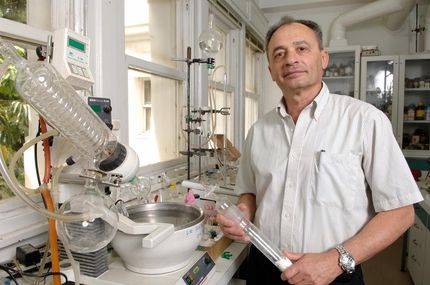New aerogels could clean contaminated water, purify hydrogen for fuel cells
Scientists at the U.S. Department of Energy's Argonne National Laboratory have identified a new technique for cleansing contaminated water and potentially purifying hydrogen for use in fuel cells, thanks to the discovery of a innovative type of porous material.
Argonne materials scientists Peter Chupas and Mercouri Kanatzidis, along with colleagues at Northwestern and Michigan State universities, created and characterized porous semiconducting aerogels at Argonne's Advanced Photon Source (APS). The researchers then submerged a fraction of a gram of the aerogel in a solution of mercury-contaminated water and found that the gel removed more than 99.99 percent of the heavy metal. The researchers believe that these gels can be used not only for this kind of environmental cleanup but also to remove impurities from hydrogen gas that could damage the catalysts in potential hydrogen fuel cells.
"When people talk about the hydrogen economy, one of the big questions they're asking is 'Can you make hydrogen pure enough that it doesn't poison the catalyst?'" Chupas said. "While there's been a big push for hydrogen storage and a big push to make fuel cells, there has not been nearly as big a push to find out where the clean hydrogen to feed all that will come from."
The aerogels, which are fashioned from chalcogenides are expected to be able to separate out the impurities from hydrogen gas much as they did the mercury from the water: by acting as a kind of sieve or selectively permeable membrane. The unique chemical and physical structure of the gels will allow researchers to "tune" their pore sizes or composition in order to separate particular poisons from the hydrogen stream.
"You can put in elements that bind the poisons that are in the stream or ones that bind the hydrogen so you let everything else fall through," Chupas said. For example, gels made with open platinum sites would extract carbon monoxide, a common catalyst poison, he explained.
The research team had not intended to create the aerogels, but their discovery proved fortunate, said Kanatzidis. Originally, the researchers had used surfactants to produce porous semiconducting powders instead of gels. When one of the researchers ran the synthesis reaction without the surfactant, he noticed that gels would form time after time. "When we saw that these chalcogenides would make a gel, we were amazed," said Kanatzidis. "We turned the flask upside down and nothing flowed."
Generally, such reactions produce only uninteresting precipitates at the bottom of the flask, he said, so that in this case, "we knew we had something special."
Kanatzidis and his co-workers recognized that aerogels offered one remarkable advantage over powders: because the material maintained its cohesion, it possessed an enormous surface area. One cubic centimeter of the aerogel could have a surface area as large as a football field, according to Kanatzidis. The bigger the surface area of the material, the more efficiently it can bind other molecules, he said.
Previous experiments into molecular filtration had used oxides rather than chalcogenides as their chemical constituents. While oxides tend to be insulators, most chalcogenides are semiconductors, enabling the study of their electrical and optical characteristics. Kanatzidis hopes to examine the photocatalytic properties of these new gels in an effort to determine whether they can assist in the production, and not merely the filtration, of hydrogen.
Unlike periodic materials, which possess a consistent long-range structure, the gels formed by the Northwestern and Argonne researchers are highly disordered. As a result, conventional crystallographic techniques would not have effectively revealed the structure and behavior of the gels. The high-energy X-rays produced by the APS, however, allowed the scientists to take accurate readings of the atomic distances within these disorganized materials. "This is where the APS really excels. It's the only place that has a dedicated facility for doing these kinds of measurements, and it allows you to wash away a lot of old assumptions about what kinds of materials you can and cannot look at," Chupas said.
Original publication: "Porous semiconducting gels and aerogels from chalcogenide clusters"; Science 2007.
Most read news
Topics
Organizations
Other news from the department science

Get the analytics and lab tech industry in your inbox
By submitting this form you agree that LUMITOS AG will send you the newsletter(s) selected above by email. Your data will not be passed on to third parties. Your data will be stored and processed in accordance with our data protection regulations. LUMITOS may contact you by email for the purpose of advertising or market and opinion surveys. You can revoke your consent at any time without giving reasons to LUMITOS AG, Ernst-Augustin-Str. 2, 12489 Berlin, Germany or by e-mail at revoke@lumitos.com with effect for the future. In addition, each email contains a link to unsubscribe from the corresponding newsletter.





















































